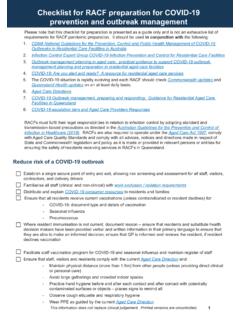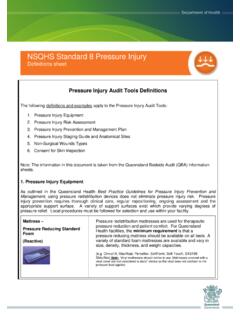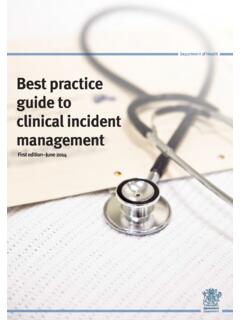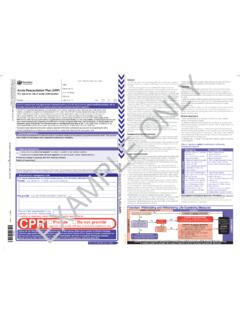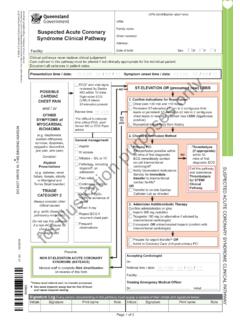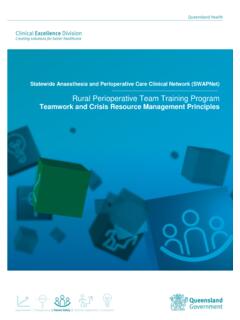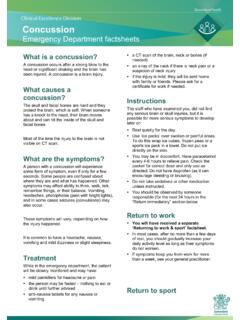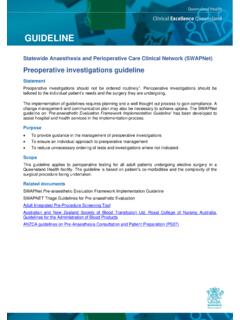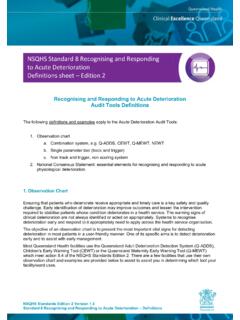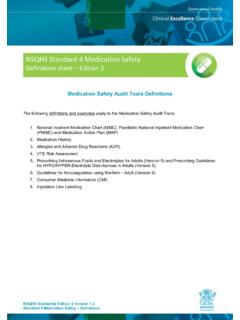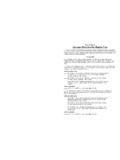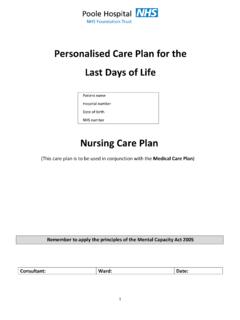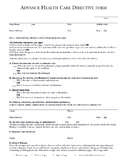Transcription of NSQHS Standard 5 Comprehensive Care Definitions sheet ...
1 NSQHS Edition 2 Version Standard 5 Comprehensive care Definitions Comprehensive care Audit Tools Definitions The following Definitions and examples apply to the Comprehensive care Audit Tools: Comprehensive care planning and delivery Comprehensive care at the end of life Preventing and managing pressure injuries 1. Pressure Injury Support Surfaces Information 2. Pressure Injury Risk Assessment 3. Pressure Injury Prevention and Management Plan 4. Comprehensive Skin Inspection Information 5. Non-Surgical Wound Information 6. Pressure Injury Staging Guide Note: The information in this document is taken from the Queensland Bedside Audit (QBA) information sheets.
2 Preventing falls and harm from falls 1. Bed Rails 2. Falls Risk Screen and Assessment 3. Falls Prevention Plan (FPP) Note: The information in this document is taken from the Queensland Bedside Audit (QBA) information sheets. NSQHS Standard 5 Comprehensive care Definitions sheet Edition 2 NSQHS Edition 2 Version Standard 5 Comprehensive care Definitions - 2 - nutrition and hydration Preventing delirium and managing cognitive impairment NSQHS Edition 2 Version Standard 5 Comprehensive care Definitions - 3 - Comprehensive care at the end of life National Consensus Statement: essential elements for safe and high-quality end-of- life care 2015, ACSQHS end of life care patient audit tool and clinician survey #end-of- life - care -audit-tool Acute Resuscitation Plan care Plan for the Dying Person NSQHS Edition 2 Version Standard 5 Comprehensive care Definitions - 4 - Statement of Choices NSQHS Edition 2 Version Standard 5 Comprehensive care Definitions - 5 - Advance Health Directive Power of Attorney NSQHS Edition 2 Version Standard 5 Comprehensive care Definitions - 6 - Preventing and managing pressure injuries 1.
3 Pressure Injury Support Surfaces Information Definitions1: Support Surfaces are specialised devices for pressure redistribution designed for management of tissue loads, microclimate, and/or other therapeutic functions, any mattress, integrated bed system, mattress replacement, overlay or seat cushion overlay .1 Active Support Surface is a powered support surface that produces alternating pressure through mechanical means and has the ability to change its load distribution properties with or without an applied load. Reactive Support Surface is a powered or non-powered support surface with the ability to change its load distribution properties only in response to an applied load.
4 1 Prevention and Treatment of Pressure Ulcers: Clinical Practice Guidelines 2014 NSQHS Edition 2 Version Standard 5 Comprehensive care Definitions - 7 - Bedding Description Standard pressure reducing foam mattress (now called Reactive (unpowered) foam mattress) Pressure redistribution mattresses are used for therapeutic pressure reduction and patient comfort. They should be placed directly on top of the bed frame. For Queensland Health facilities, the minimum requirement is that a pressure reactive unpowered foam mattress should be available on all beds. A variety of Standard foam mattresses are available and vary in size, density, thickness, and weight capacities ( Cirrus1A, Maxifloat, Pentaflex, SoftForm, Soft Touch, SXS198 Simuflex, NP200).
5 Pressure reducing overlay - unpowered (now called Reactive (unpowered) overlay) Unpowered overlay devices that may be composed of gel, air, foam or a combination of these products. Alternating mattress - replacement (now called Active (powered) alternating mattress replacement) Alternating air mattresses replace reactive (unpowered) foam mattresses ( Active Alpha Response 4, Auto logic 200, Bi-wave Carer, Cairwave, ClinActiv, Nimbus, Nodec 3, Proficare, Talley Quattro). They should be placed directly on top of the bed frame. Alternating mattress - overlay (now called Active (powered) alternating mattress overlay) Alternating mattress overlays are used in conjunction with reactive (unpowered) foam mattresses and are placed on top of these mattresses and not directly on the bed frame ( Autologic 110, AlphaXcell, Alpha Response 3).
6 NSQHS Edition 2 Version Standard 5 Comprehensive care Definitions - 8 - Special/self-adjusting mattress (now called Reactive (powered/unpowered) self-adjusting mattress) High specification mattresses for pressure redistribution and are at constant low pressure (not alternating or low air loss). They can be specialty foam with air cells ( Accumax, AtmosAir). They should be placed directly on top of the bed frame. In some instances a pump may be attached to the mattress. Specialty bed system (now called Powered specialty bed system) An integrated bed and mattress system which incorporates a bed frame and a powered mattress or surface which is alternating, low air loss, constant low pressure, or air-fluidised for the purpose of redistribution.
7 They may offer kinetic movement, bariatric capabilities, various positioning options, and imaging compatible surfaces. Bed and mattress cannot be used exclusively of each other ( Total care Bed, Therapulse, Versa care , Total lift, In Touch, Progressa, Compella). Vinyl mattress Vinyl covered, single layered foam mattress. This is not considered a static device as the vinyl does not conform to the pressure load applied. Vinyl mattresses should not be in use. Vinyl mattresses are no longer recommended in Queensland Health. Chairs Pressure reducing chair (now called Reactive chair) Pressure redistribution chairs at the bedside are more than the Standard bedside chair.
8 They do not require a foam cushion to be put on top of the seat surface because an integrated cushion with specialty foam is built into the chair, as well as a specialty cover. Note: There is a two-way stretch vapour permeable fabric over high density foam. Cushion air/gel, foam, other (now called Reactive/Active cushion) Unpowered devices that may be composed of gel, air, foam or a combination of these products. The cushion is used in place of or in addition to a basic chair/wheelchair base/cushion. These products are not alternating or low air loss (reactive) ( Jay, Roho, Equagel, MacMed). Foam cushions should be high density foam with similar construction to the reactive (unpowered) foam mattress.
9 NSQHS Edition 2 Version Standard 5 Comprehensive care Definitions - 9 - Cushions that are used in place of or in addition to a basic chair/ wheelchair base/ cushion and are powered, alternating or low air loss (active) ( Aura). Positioning devices Gel pads Gel pad used for positioning or to reduce shear and to provide pressure redistribution. Heel elevator Heel elevator or boot wedge used for positioning or to reduce shear and to provide pressure redistribution. Device may present in various ways- foam, fibre, air filled. Bed cradle Bed cradle used for offloading of bed linen. Extra pillow Extra pillow can be used for pressure relieving if no other devices are available.
10 NSQHS Edition 2 Version Standard 5 Comprehensive care Definitions - 10 - 2. Pressure Injury Risk Assessment The health service organisation providing the service to patients at risk of pressure injuries has systems for pressure injury prevention and wound management that are consistent with best-practice ,5 A pressure injury risk assessment is a formal scale, or score used to determine the degree of pressure injury risk. Examples of validated scales for assessing pressure injury risk in adults include the Waterlow Score, Braden Scale and Norton Examples of validated scales for paediatric patients include the Glamorgan Risk Assessment Scale and Braden Q.
